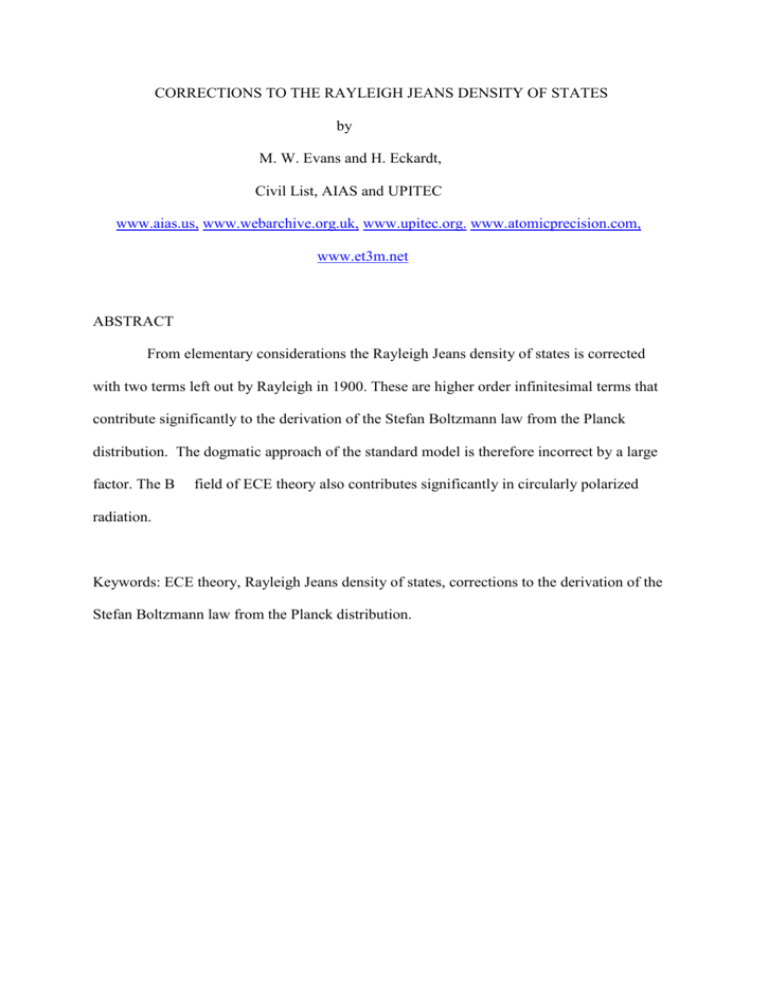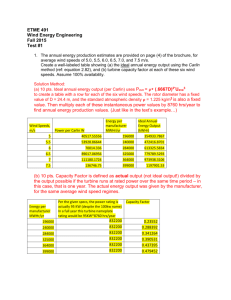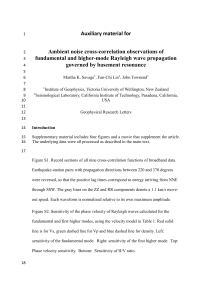CORRECTIONS TO THE RAYLEIGH JEANS DENSITY OF STATES
advertisement

CORRECTIONS TO THE RAYLEIGH JEANS DENSITY OF STATES
by
M. W. Evans and H. Eckardt,
Civil List, AIAS and UPITEC
www.aias.us, www.webarchive.org.uk, www.upitec.org. www.atomicprecision.com,
www.et3m.net
ABSTRACT
From elementary considerations the Rayleigh Jeans density of states is corrected
with two terms left out by Rayleigh in 1900. These are higher order infinitesimal terms that
contribute significantly to the derivation of the Stefan Boltzmann law from the Planck
distribution. The dogmatic approach of the standard model is therefore incorrect by a large
factor. The B
field of ECE theory also contributes significantly in circularly polarized
radiation.
Keywords: ECE theory, Rayleigh Jeans density of states, corrections to the derivation of the
Stefan Boltzmann law from the Planck distribution.
1. INTRODUCTION
Recently in this series of two hundred and ninety one papers to date {1 - 10}
the Evans Morris effects have been analyzed with various theories of refraction and
reflection. It has been shown that the dogmatic approach to the theory of reflection and
refraction is trivially incorrect. Elementary considerations of geometry show that the incident,
reflected and refracted frequencies cannot be the same in general. The Evans Morris effects
are colour changes in laser beam reflected and refracted from various materials, as described
on the diary or blog of www.aias.us. During the course of extending the analysis to
polychromatic radiation it became necessary to correct the Rayleigh Jeans density of states of
1900 and 1905 for two terms left out by Rayleigh and by Jeans. These higher order
infinitesimal terms are described in Section 2, where it is shown that they result in a large
correction to the Rayleigh Jeans density of states. It is shown that the B field of ECE theory
also results in a large correction when the radiation is circularly polarized.
2. CORRECTIONS OF THE RAYLEIGH JEANS LAW AND PLANCK DISTRIBUTION
Consider the number of oscillators N in a volume V of radiation (the number
density) in the original Rayleigh calculation of 1900:
where
is the angular frequency of monochromatic radiation and where c is the vacuum
speed of light. The infinitesimal of number density was defined by Rayleigh as:
and he doubled this result by assuming that the radiation contains two states of polarization.
Presumably these are right and left circularly polarized . Therefore:
Rayleigh left out the second two terms of Eq. (
) without attempting to justify the
approximation, so the dogmatic Rayleigh Jeans density of states is:
The number of oscillators N in a radiation volume V of polychromatic radiation is
found by integrating over frequencies:
This is the dogmatic Rayleigh Jeans density of states. It is well known to be incorrect at high
frequencies because it goes to infinity. It is also well known that it was corrected by the use
of the 1899 quantum theory of Planck, in which the average energy of a radiation oscillator
is:
where:
under the condition:
The infinitesimal of energy density from this theory is:
and the energy density of radiation in joules per cubic metre is found by integrating over
frequency:
Using the dogmatic assertion (
) of Rayleigh, it is found that:
In order to derive the experimental Stefan Boltzmann law a black body was defined as
having frequencies in the range from zero to infinity, so:
This is the old Stefan Boltzmann law derived from the Planck distribution. The energy U per
volume V of radiation from a black body radiator is proportional to the fourth power of
temperature. The number of Planck / Einstein photons of energy
from Eq. (
):
For a black body radiator:
per volume V is,
where
is the third zeta function defined by:
In the old theory the number of photons
per volume V of a black body radiator is
proportional to the cube of temperature.
Both calculations used the dogmatic Rayleigh Jeans density of states (
)
uncritically, and these calculations have always been claimed to verify the old quantum
theory. It is straightforward to show as follows that these claims are not true. The correct
density of states is Eq. (
), in which the second two terms contribute more oscillators
per unit volume as follows.
Write Eq. (
) as:
where:
and:
with the original Rayleigh term as:
From Eq. (
From Eq. (
Integrating Eq. (
):
):
) over frequency:
so there exists a number density of oscillators:
Similarly, integrating Eq. (
):
so there exists a second number density of oscillators:
The total number of oscillators in a volume V of radiation is therefore:
The original Rayleigh result is:
So the correction factor is 10 / 3, more than a factor three. The correct result (
) must be
obtained by integration of:
so the corrected Rayleigh Jeans density of states is:
This must be used in the calculation of the Stefan Boltzmann law as described already. The
proportionality constant of the Stefan Boltzmann law is increased by 10 / 3.
In Note 291(2) the evaluation of the definite integral:
is considered using the Riemann integration technique, and it shown that:
so
Finally in Note 291(3) it is shown that the B
field of ECE theory contributes a
classical energy density
to circularly polarized radiation where
amplitude of the electric field strength and
is the vacuum permeability, E
is the
is the vacuum permittivity. This increases
the energy density by a factor of 5 / 4, so in circularly polarized radiation the complete
correction to the Rayleigh Jeans law is
In amorphous black body radiation however the B(3) field cancels to zero because it changes
sign between right and left handed circularly polarized components.
These corrections to the original Rayleigh Jeans density of states (
) mean that
the experimental testing of the law must be rethought, because Rayleigh’s derivation contains
unjustifiable approximations.
ACKNOWLEDGMENTS
The British Government is thanked for a Civil List Pension, and the staff of AIAS
and others for many interesting discussions. Dave Burleigh is thanked for posting, Alex Hill
for translation and broadcasting, and Robert Cheshire for broadcasting.
REFERENCES
{1} M .W. Evans, H. Eckardt, D. W. Lindstrom and S. J. Crothers, “Principles of ECE
Theory” (in prep., open source as UFT281 to UFT288 on www.aias.us and softback).
{2} M .W. Evans, Ed., J. Found. Phys. Chem., (open source on www.aias.us, Cambridge
International Science Publishing, www.cisp-publishing.com, CISP, 2011).
{3} M .W. Evans, Ed. “Definitive Refutations of the Einsteinian General Relativity” (Open
source on www.aias.us, CISP 2012).
{4} M. W. Evans, S. J. Crothers, H. Eckardt and K. Pendergast, “Criticisms of the
Einsteinian General Relativity” (open source on www.aias.us, CISP 2010).
{5} M .W. Evans, H. Eckardt and D. W. Lindstrom, “Generally Covariant Unified Field
Theory”(open source on www.aias.us , , Abramis 2005 to 2011) in seven volumes softback.
{6} L. Felker, “The Evans Equations of Unified Field Theory” (Abramis 2007).
{7} M. W. Evans and L. B. Crowell, “Classical and Quantum Electrodynamics and the B(3)
Field” (open source on www.aias.us and World Scientific, 2001).
{8} M .W. Evans and S. Kielich, Eds. “Moden Nonlinear Optics” (Wiley, New York, 1992,
1993, 1997, 2001) in two editions and six volumes, partially open source on www.aias.us
{9} M .W. Evans and J. - P. Vigier, “The Enigmatic Photon”, (open source on www.aias.us
and Kluwer, 1994 to 2002 five volumes hardback, five volumes softback).
{10} M .W. Evans and A. A. Hasanein, “The Photomagneton in Quantum Field Theory”
(World Scientific, 1994).







